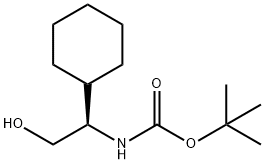N-BOC-D-2-Amino-2-Cyclohexyl-Ethanol(CAS# 188348-00-7)
Risk and Safety
| Risk Codes | R22 – Harmful if swallowed R36/37/38 – Irritating to eyes, respiratory system and skin. R50/53 – Very toxic to aquatic organisms, may cause long-term adverse effects in the aquatic environment. |
| Safety Description | S26 – In case of contact with eyes, rinse immediately with plenty of water and seek medical advice. S60 – This material and its container must be disposed of as hazardous waste. S61 – Avoid release to the environment. Refer to special instructions / safety data sheets. |
| UN IDs | UN 3077 9/PG 3 |
| WGK Germany | 3 |
N-BOC-D-2-Amino-2-Cyclohexyl-Ethanol(CAS# 188348-00-7) Introduction
1. Appearance: N-Boc-D-Cyclohexylglycinol is a white crystalline solid.
2. Melting Point: about 100-102 ℃.
3. Solubility: N-Boc-D-Cyclohexylglycinol has good solubility in common organic solvents.
Primary Use:
N-Boc-D-Cyclohexylglycinol is generally used as an intermediate in the field of medicine. It can be used to synthesize biologically active compounds, such as peptide drugs and lead compounds for pharmaceutical products.
Method:
The preparation of N-Boc-D-Cyclohexylglycinol is usually carried out by the following steps:
1. Reaction of D-cyclohexylglycine with Boc2O (tert-butoxycarbonyl chlorinating agent) to generate N-Boc-D-Cyclohexylglycinol.
Safety Information:
N-Boc-D-Cyclohexylglycinol are chemicals, should pay attention to safe operation. It may irritate the eyes, skin and respiratory system. Wear appropriate personal protective equipment such as lab gloves and eye protection during use. In addition, it should be operated in a well-ventilated area and protected from inhalation or contact with skin. If inhaled or exposed by accident, seek medical attention immediately and show the relevant information to the doctor.








